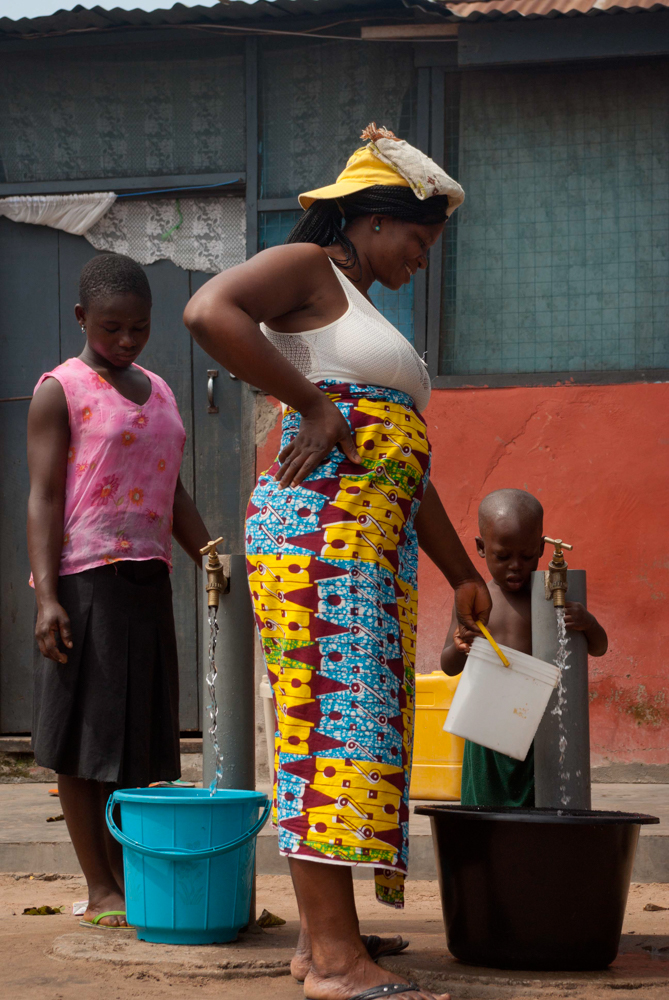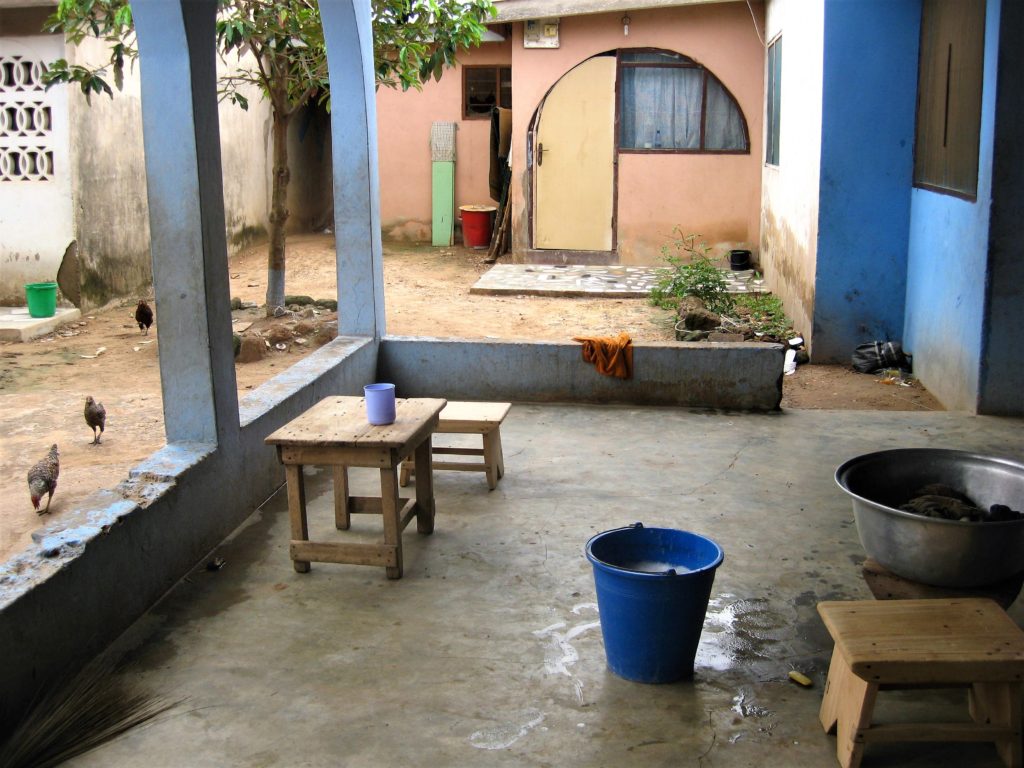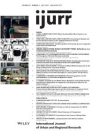In 2010, Ghana succeeded in halving the proportion of its population without sustainable access to safe drinking water. The West African nation met the drinking water target for the Millennium Development Goals (MDGs) five years ahead of the 2015 deadline (Ghana Statistical Services, 2013). That year, we started working in Accra, documenting water access for urban residents in the aftermath of recent privatization of the country’s urban water systems. In the shadows of Ghana’s success story, we observed variegated access to water across the capital city. We witnessed the creative strategies of citizens navigating the waterscape as it changed from one day to the next.
Globally, 2 out of every 5 people are currently affected by water scarcity (UNDP, 2018). While we might readily think of places that regularly make headlines, like Cape Town, South Africa; Flint, USA; or Sao Paolo, Brazil, many of those affected by shortages are residents like those we encountered in Accra. Their struggle is mundane and enduring. It is lived in the absence of sustained drought or contamination. It is far from the epicenters of water crises. In this spotlight essay, we pay attention to the everyday water challenges that hang in juxtaposition to these punctuated and notable crises. We provide a glimpse into lived experiences of water access emerging from our research in Accra, Ghana to share a story of water needs that extend beyond access to a pipe (see also Peloso and Morinville, 2014; Morinville, 2012; Morinville and Harris, 2013, 2014; Peloso, 2014; Dapaah, 2014; Morinville, 2017; Peloso and Harris, 2017; www.edges.sites.olt.ubc.ca/).

Woman filling up water buckets from a stand pipe in Nima, Accra. Chasing for Water, Accra, Ghana. Photo: Cynthia Morinville, 2011.
Looking away from crisis offers us a vantage point to start thinking about dimensions of water access beyond the urgency of quickly-fading headlines. Urban water crises are too often portrayed as outcomes of technical failures, thus solvable by technical means. It is precisely this lens that obscures a more fulsome understanding of water access, quality, and affordability. Here, we focus on these elements in urban areas of the burgeoning city of Accra, Ghana, to enliven an understanding that we contend is critical in confronting water challenges, now and into the future.
Everyday negotiation of water struggle and access
Global efforts to define, measure and achieve universal water access often presume that urban residents rely on a singular or primary source of water for their drinking needs. In Accra, however, residents meet their daily water needs through a dynamic patchwork of sources (Peloso and Morinville, 2014). For example, residents may gain access to water from tankers, stand pipes, and sachet or packaged water (Stoler, 2012, 2017; Stoler at al., 2012a, 2012b, 2015; Morinville, 2012, 2017). Recent data also suggests that sachet water is now the primary drinking water source in some parts of Accra (Stoler, 2017). Considerable research has highlighted the significant role of informal and private sectors in extending water delivery beyond centralized utilities, particularly in unregulated housing areas where potable water services have not kept pace with population growth (Collignon and Vézina, 2000; Bakker, 2003; Kjellén and McGranahan, 2006; Allen et al., 2006; Songsore, 2008; Stoler et al., 2012a). This growing body of research sheds light on the diversity of arrangements that urban residents navigate to access water.
In Accra, variegated water access can be traced back to legacies of uneven infrastructural development during the colonial period, coupled with a long-standing water rationing schedule that was in effect until very recently. These histories live on in the flow of water, which is cut off in parts of the city each day, so that citizens have learned to meet their daily water needs creatively. Recognizing that urban residents access water through multiple sources also means acknowledging that they are simultaneously drawing on “improved” and “unimproved” sources—rather than exclusively one or the other. The multiplicity and complexity of these hydro-social networks and entanglements significantly complicate notions of universal access that tend toward models of neatly piped and centralized water networks.
It is also important to reiterate that having access to a pipe (a primary focus of most “safe access” statistics) does not guarantee water delivery. In low-income urban areas, water flows are often intermittent, pipes may be in disrepair, and cut-offs are common when fees are unpaid (Dapaah, 2014). Water storage is a popular way of contending with this problem and large plastic water tanks often tower next to houses throughout Accra. These complex details of how access is negotiated in ways that supplant, supplement, and at times overlap formal water service provision from centralized utilities are often rendered mute by statistical portraits.
In order to critically understand the urban citizen’s struggle for water, it is clear that we need to more fully account for heterogeneous access as a key dimension of water security. Achieving universal water access will require that we critically examine the circuitry of water access and security with an eye towards the needs and capabilities of urban residents. For example, the flexibility to pursue multiple sources of water on a day-to-day basis can help to address frequent shortages in piped water services (Peloso and Morinville, 2014). Residents of emerging neighbourhoods or recent migrants to urban areas may opt out of laying down a piped connection to their homes, seeing it as an unwise investment, ill-suited to the transient nature of their living circumstances, or the intention to relocate within the city. Indeed, the ability to be opportunistic and nimble, following and responding to frequently interrupted flows of water, involves enrolling diverse capacities to improvise, to connect to multiple sources, and to negotiate water quantity and affordability needs on a daily basis (Peloso and Morinville, 2014).

A shared courtyard in Ashaiman, a settlement outside of Accra, showing vessels of water for washing and bathing. Photo: Megan Peloso, 2012.
Affordability concerns are also central to everyday water access in Accra, although this important consideration nonetheless continues to fall outside of many definitions of “safe access” to water (JMP, 2017b). Taking affordability concerns seriously requires that we understand the issue differently. Installing infrastructure to provide access to improved sources of water without consideration of cost, affordability and perception may drive people to shift to unsafe sources that they can afford (McMahon, 2003). For example, when a desalination plant brought a new source of water to the eastern part of the city, the cost continued to constitute a financial barrier to access for residents (Tremblay, 2015). In Accra, the central utility (Ghana Water Company Ltd., GWCL) offers the lowest per-unit rate for water, while water purchased from informal vendors, or procured from sachet and bottled water, is sold at a premium –with significantly higher rates per unit (Peloso and Morinville, 2014). Yet, given limited disposable income, residents may prefer obtaining water through smaller, low-cost, repetitive transactions (see also Torio, 2016). A form of security may also arise from the ability to pay for water consumption upfront, or to negotiate credit through trusted networks such as with kin or neighbours, as opposed to risking the possibility of accruing debt or being unable to pay the utility’s post-consumption bills (Peloso and Morinville, 2014).
Recognizing these elements should neither be taken to deny the barriers to agency in the face of uneven or interrupted water services, nor should it take our attention away from the stress involved in dealing with informal vendors and multiple transactions (see Wutich, 2009). In Accra, the word chase was evoked to illustrate the haste, wit and toil involved in securing water in the absence of a reliable connection to the official water network. While we attempt to give voice to the many features of flexible and variable access to water afforded by the informal sector—and the agency of residents therein—it is no less true that urban Ghanaians also spoke of a piped connection as a commodity emblematic of a life to which they aspire. Arguably, the municipal utility remains ‘the gold standard’ for water access. In fact, it will likely to be essential in ensuring that an ethic of universal access is upheld (Hawkins, 2017; Morinville, 2017).
Yet, informal services extend water access beyond the reach of the pipe, and represent a reconfiguration of the water network that is based on meeting people where they are (Yeboah, 2006, Peloso and Morinville 2014).With uncertainty at the forefront of daily access to water, maintaining several access points was a clear adaptation to maintain a certain level of water security (Peloso and Morinville, 2014). Paying attention to everyday experiences of water access may help to support some of the pathways that currently contribute to water security amongst the urban poor (Yeboah, 2006; Jepson et al., 2017), and allows us to shift our focus away from a singular and narrow piped delivery approach that too often misses the mark.
In conclusion, informal and private sector services can provide alternative forms of water security through multiple sources, flexibility and day-to-day affordability. Of course, quotidian alternative-making requires hard work, resourcefulness and mobility. The tension between the flexibility and convenience afforded by informal patchwork water access and the emblematic security of the formal grid system remains central to the unanswered question of universal water access. We must at once keep a focus on longer term goals of universal, safe and affordable water access, while acknowledging that a myopic and singular focus on connectivity to a centralized utility service oversimplifies the complex experience of water insecurity for millions of residents across the globe. Achieving the goal of universal water access necessitates that we fundamentally rethink our understanding of water as a material good and critically examine our approach to how water should be provided and accessed (see also Linton, 2010; Swyngedouw, 1999; Linton and Budds, 2014; Jepson et al., 2017, Jepson et al., 2019). Doing so reorients our focus from water pipes and infrastructure to the social relationships that are necessarily entangled with water access and security.
Megan Peloso (University of British Columbia, Institute for Resources, Environment, and Sustainability)
Cynthia Morinville (University of Toronto, Department of Geography and Planning)
Leila M. Harris (University of British Columbia, Institute for Resources, Environment, and Sustainability)
All essays on Parched Cities, Parched Citizens
Introduction
Liza Weinstein
Water Crisis
Nikhil Anand
Beyond ‘Third World’ Comparisons: America’s Geography of Water, Race, and Poverty
Malini Ranganathan
Crisis Temporalities: Intersections Between Infrastructure and Inequality in the Cape Town Water Crisis
Suraya Scheba & Nate Millington
Water Scarcity Beyond Crisis: Spotlight on Accra
Megan Peloso, Cynthia Morinville & Leila M. Harris
Water Crisis and Eco-Apartheid in São Paulo: Beyond Naive Optimism About Climate-Linked Disasters
Daniel Aldana Cohen
Related IJURR articles on Parched Cities, Parched Citizens
Conduct of conduits: engineering, desire and government through the enclosure and exposure of urban water.
Usher, Mark
Urban Warfare Ecology: A Study of Water Supply in Basrah.
Zeitoun, Mark, et al.
Worlding water supply: thinking beyond the network in Jakarta.
Furlong, Kathryn, and Michelle Kooy
The political ecology of virtual water in Southern Spain.
Beltrán, Maria J., and Esther Velázquez
Debate on Karen Bakker’s Privatizing Water.
Punjabi, Bharat
Paying for pipes, claiming citizenship: Political agency and water reforms at the urban periphery.
Ranganathan, Malini
Experiments and counter‐experiments in the urban laboratory of water‐supply partnerships in India.
Gopakumar, Govind
The Changing Nature of Border, Scale and the Production of Hong Kong’s Water Supply System since 1959.
Lee, Nelson K
Atlantic gardens in Mediterranean climates: Understanding the production of suburban natures in Barcelona.
Parés, Marc, Hug March, and David Saurí
Maintaining climate change experiments: urban political ecology and the everyday reconfiguration of urban infrastructure.
Broto, Vanesa Castán, and Harriet Bulkeley
Gender water networks: femininity and masculinity in water politics in Bolivia.
Laurie, Nina
© 2018 THE AUTHOR. INTERNATIONAL JOURNAL OF URBAN AND REGIONAL RESEARCH, PUBLISHED BY JOHN WILEY & SONS LTD UNDER LICENSE BY URBAN RESEARCH PUBLICATIONS LIMITED
This is an open access article under the terms of the Creative Commons Attribution-NonCommercial-NoDerivs License, which permits use and distribution in any medium, provided the original work is properly cited, the use is non-commercial and no modifications or adaptations are made.
